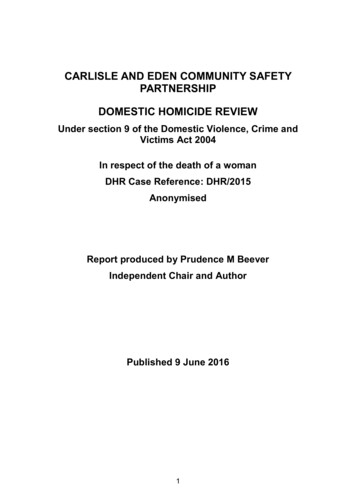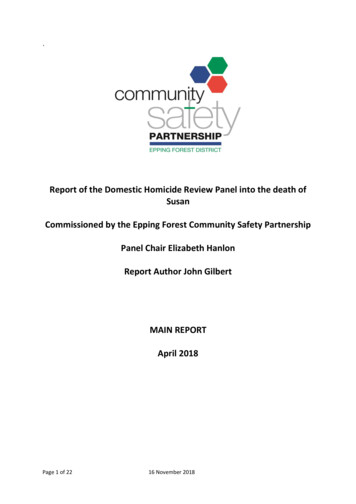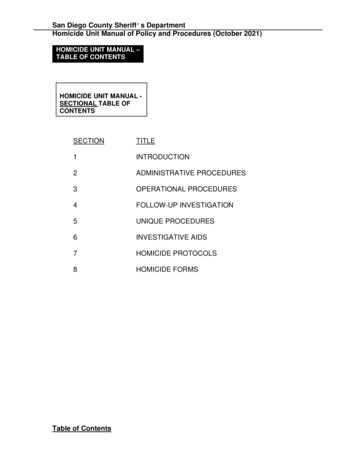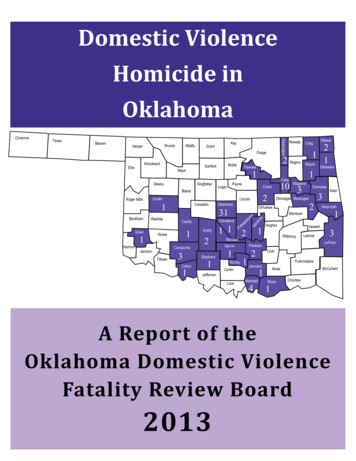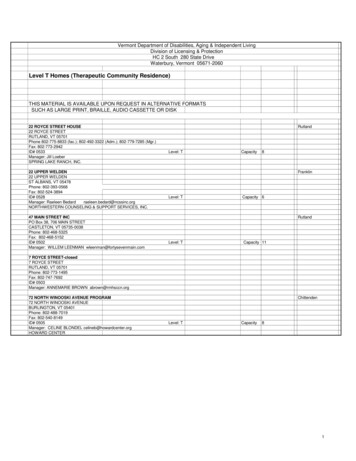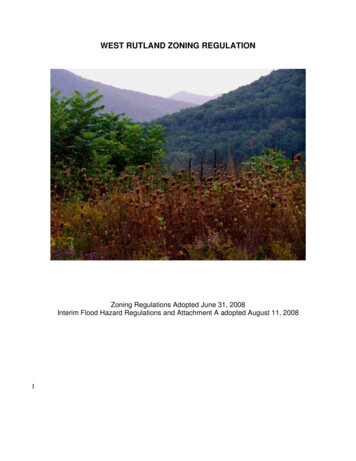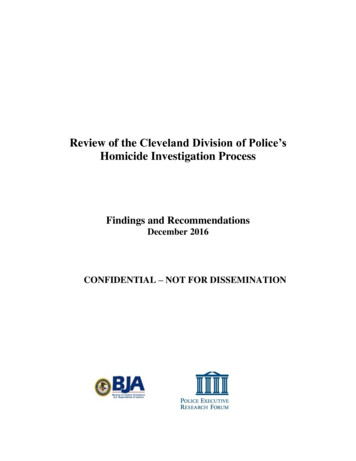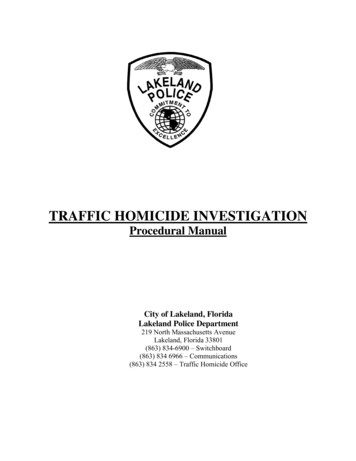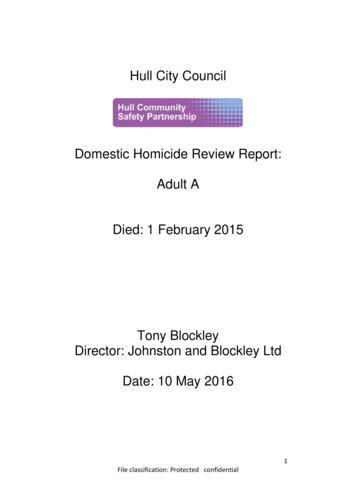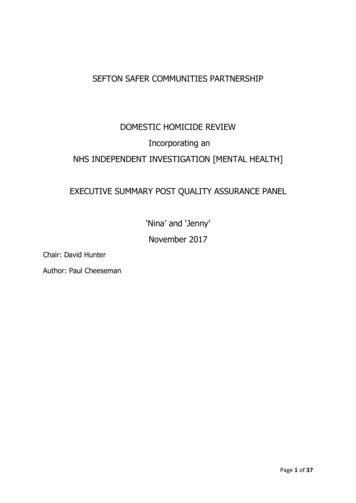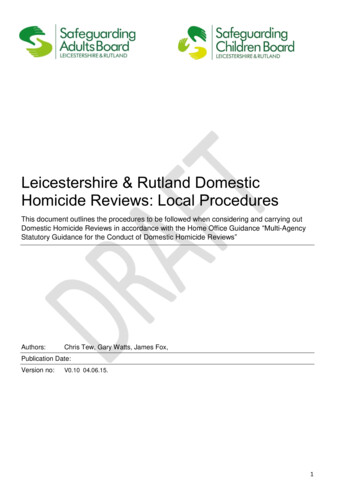
Transcription
Leicestershire & Rutland DomesticHomicide Reviews: Local ProceduresThis document outlines the procedures to be followed when considering and carrying outDomestic Homicide Reviews in accordance with the Home Office Guidance “Multi-AgencyStatutory Guidance for the Conduct of Domestic Homicide Reviews”Authors:Chris Tew, Gary Watts, James Fox,Publication Date:Version no:V0.10 04.06.15.1
IntroductionDefinition in the Home Office guidance:1“Domestic homicide review means a review of the circumstances in which the deathof a person aged 16 or over has, or appears to have, resulted from violence, abuseor neglect by –(a) A person to whom he was related or with whom he was or had been in anintimate personal relationship, or(b) A member of the same household as himself, held with a view toidentifying the lessons to be learnt from the death” (p. 7, para 12).On the 1st August 2013, the Home Office published the revised “Multi-Agency StatutoryGuidance for the Conduct of Domestic Homicide Reviews”, which was created as part ofthe framework of the over-arching “Domestic Violence, Crime and Victims Act 2004”(section 9[3]).The purpose for undertaking Domestic Homicide Reviews (DHRs) is to: 1.Establish what lessons are to be learned from the domestic homicide regarding theway in which local professionals and organisations work individually and together tosafeguard victimsIdentify clearly what those lessons are both within and between agencies, how andwithin what timescales they will be acted on, and what is expected to change as aresultApply these lessons to service responses including changes to policies andprocedures as appropriatePrevent domestic violence homicide and improve service responses for all domesticviolence victims and their children through improved intra and inter-agency working(p. 6, para 7).BackgroundThe 8 Community Safety Partnerships (CSPs) in Leicestershire and Rutland have agreed,through the Leicestershire Safer Communities Strategy Board (LSCSB), to commission theLeicestershire & Rutland Safeguarding Boards to manage the review process through thejoint Safeguarding Adults Board (SAB) & Local Safeguarding Children Board (LSCB)Serious Case Review (SCR) Subgroup.From the Home Office perspective, the CSP in the area where the homicide took place willremain the accountable body responsible for funding and commissioning the reviews;however, locally, all DHR activity is managed through the Safeguarding Boards tem/uploads/attachment data/file/209020/DHR Guidance refresh HO final WEB.pdf2
Office (SBBO) which also acts as the single point of contact for the Home Office on DHRs.The management of the multi-agency recommendations and the completion of actions,along with any resulting learning events, is the responsibility of the County CouncilCommunity Safety Team through the Domestic Abuse Partnership on behalf of the CSPs.The Chair of the geographically relevant CSP will be responsible for individual DHRdecisions including the need to hold a DHR, on the basis of recommendations from theLSCB/SAB conjoined SCR Subgroups meeting.For updates from the Home Office, please visit their domestic-homicide-reviewThe following pages set out the local process for the completion of DHRs acrossLeicestershire & Rutland, which has been adapted from the revised statutory guidancepublished by the Home Office (August 2013).2.Determining the need for a review2.1.Notifications of deathsWhen a domestic homicide occurs the police should inform the relevant Community SafetyPartnership in writing of the incident. Where the deceased is aged 16 or 17 years, then theChild Death Overview Panel (CDOP) should also be made aware.Any professional or agency/organisation may refer such a homicide to the CSP in writing.In Leicestershire and Rutland the process is managed as follows:2 When the police or another agency/organisation are made aware of an adult death(this now includes 16 and 17 year olds) and where the circumstances may meet thecriteria2 for a DHR, there is an expectation that they will notify the SBBO manager oran officer within a reasonable time frame of the death occurring. The SBBO in turnnotifies the head of the Leicestershire County Council Community Safety Team assoon as possible who will then liaise with the Chair of the relevant Community SafetyPartnership (CSP) Although the initial information can be given verbally, a written report of thecircumstances will be produced to comply with the national DHR procedures and toinform the relevant CSP Chair and SCR Subgroup Where a victim normally resides in Leicestershire or Rutland but their death occursoutside Leicestershire and Rutland and circumstances meet the criteria for a DHR,the responsibility for completing a DHR sits with the CSP where the victim’s lastknown address was recorded.The definition of the circumstances surrounding a death to meet DHR criteria can be found on page 5.3
2.2.Where a victim normally resides outside of Leicestershire or Rutland but their deathoccurs in Leicestershire and Rutland and circumstances meet the criteria for a DHR,the responsibility for completing a DHR sits with the CSP where the victim’s lastknown address was recorded.Working with other areasWhere another CSP outside of Leicestershire and Rutland is completing a DHR within theirarea and they have reason to believe the individuals involved may be known to agencieswithin Leicestershire or Rutland, the CSP should write to the SBBO who will liaise with theHead of the Leicestershire County Council Community Safety Team. A trawl for informationfrom local agencies/organisations will be conducted on behalf of the requesting CSP, andwhere possible, working to the requesting CSPs existing timescales.2.3.Referring Cases for considerationThe case will be referred to the next planned Safeguarding Boards SCR Subgroup meetingunless the circumstances of the incident require a special meeting of the Subgroup toconsider the case.The SBBO will request an initial records check from members of the SCR Subgroup anddomestic abuse specialist services. Agencies will share the outcome of their records checkat the SCR Subgroup meeting where the case is considered.Once it is known that a homicide is being considered for review, each agency withinvolvement with the victim, family or members of the household should promptly securethe agency’s records relating to the case, to guard against loss or interference.Following the meeting, a recommendation will be made by the group via the head of theCounty Council Community Safety Team to the Chair of the relevant CSP, stating if thecriteria for a DHR have been met and whether a DHR or other learning process should beconducted.The Senior Investigating Officer from Leicestershire Police may be invited to attend orcontribute to the meeting to offer the latest information in relation to ongoing investigationsand to provide any feedback from their initial contact with the family.2.4. Joint DHR with Serious Case Review (SCR) and/or Safeguarding Adult Review(SAR) processesIf it is established that the deceased was under the age of 18 or the family unit includeschildren/young people under the age of 18, the Safeguarding Boards Business Office willensure that the information is considered by the SCR Subgroup to establish if the case alsomeets the criteria for a children’s serious case review. 33The criteria for a Children’s Serious Case Review is defined by the Department of Education under thestatutory framework of “Working Together”. For more information on the LSCB, please visithttp://www.lrsb.org.uk/4
Alternatively, if it is determined that the case involves an “adult at risk”, the SBBO willensure that the information is considered by the SCR Subgroup to establish if the case alsomeets the criteria for a Safeguarding Adult Review (SAR).A link to the relevant section of the Care Act 2014 is shown section/44/enactedIf it is determined that the criteria is met for a Child SCR or an Adult SAR (in addition to aDHR), the joint SCR Subgroup will consider the case and make a recommendation to theChairs of the LSCB or SAB and the CSP, stating that the Chairs agree to undertake a jointlycommissioned process whereby the Child SCR or Adult SAR terms of reference incorporatethe DHR elements.It should be noted that when victims of domestic homicide are aged under 18, a child SCRshould take precedence over a DHR. However, it is vital that any elements of domesticviolence relating to the homicide are addressed fully and the review includesrepresentatives with a thorough understanding of domestic violence.2.5.TimescaleThe decision on whether or not to hold a DHR should normally be taken by the Chair of therelevant CSP within 1 month of a homicide coming to the attention of the SCR Subgroup.There may be circumstances where more information is required to determine theappropriate type of review.The Independent Chair of the Safeguarding Boards must be informed of the decision toconduct a DHR and will provide independent advice to the CSP Chair as necessarythroughout the process.2.6. 2.7.Options available to the SCR SubgroupTo recommend that the CSP commission a DHRTo recommend that the LSCB and CSP commission a joint DHR and child SCRTo recommend that the SAB and CSP commission a joint DHR and adult SARTo recommend that a decision is put on hold until the criminal and coronialproceedings are completedTo recommend that another type of review is commissioned (as defined in theLearning and Improvement Framework)To recommend that a review process is not undertaken.SBBO Review Officer and AdministrationWhen a decision has been made to undertake a DHR, the manager of the SBBO willappoint a SBBO Review Officer to the case and organise suitable administration support forthe DHR process.5
2.8.Notification of a decision to review (or not to review) a homicide2.8.1. Home OfficeThe Chair of the relevant CSP, through the SBBO, will notify the Home Office ofconfirmation of either a decision to review or a decision not to review a homicide.This is placed in writing to:The Home Office DHR enquiries: DHRENQUIRIES@homeoffice.gsi.gov.ukA copy of this email will also be sent to the Independent Chair of the SafeguardingBoard and the head of the County Council Community Safety Team by the SBBO.As part of the Home Office internal processes the “decisions not to review” arereviewed by their Quality Assurance Group. This Group can request additionalinformation about the case and also override the decision not to review. Whilst theGroup meets quarterly, a response may not be received by the Group for some timeafter submission. During this time the SBBO will track the case until confirmation hasbeen received by the Home Office that they are in agreement with that decision.2.8.2. CoronerThe SBBO Review Officer will notify the coroner of the CSP’s intention to conduct aDHR or other review as a matter of courtesy.2.8.3. ReferrerThe SBBO Review Officer is responsible for providing feedback to the referrer of thedecision made regarding a review.2.9.Working with the criminal process and deciding when to suspend a reviewWhere there is an ongoing police investigation or an ongoing prosecution, the PoliceDetective Chief Inspector (DCI) responsible for Adult Safeguarding will inform the SeniorInvestigating Officer (SIO), the Disclosure Officer, Family Liaison Officer (FLO) and wherenecessary the Crown Prosecutions Service of the CSP’s intention to conduct a DHR orother review.It may be appropriate to suspend a review due to ongoing criminal processes andinvestigations being undertaken. This is to ensure that the police are able to gather recordsand key witness information without interference from parallel legal processes. It isrecognised that criminal proceedings take precedence and that, if the DCI for Safeguardingwishes to make a recommendation to suspend the review, this should be done withoutdelay and in writing with an explanation of their recommendation to the Chair of the SCRSubgroup.It may be appropriate in some cases that portions of the review should be suspended: forexample, internal agencies’ reviews can be completed, but the bringing together ofinformation into a multi-agency forum needs to be delayed. Alternatively the Review Panelmay wish to delay contacting the family or interviewing key people as part of the review6
process. These decisions are taken in discussion with the Police DCI for adultSafeguarding.In some instances processes are able to run parallel: for example, where the victim and theperpetrator are both deceased. This approach should always be cleared by the Police DCIfor adult Safeguarding to ensure processes can run smoothly and without interference.3. Initiating the review3.1. Commissioning a Review Panel Chair/Overview Report AuthorOnce a decision to review has been made, the SBBO Review Officer will be responsible forsecuring the services of individuals to fill the roles of Review Panel Chair and an OverviewReport Author (these are sometimes separate or dual roles). These persons should beindependent of all the agencies/professionals directly involved in the particular case. A listof potential candidates will be drawn up and an individual chosen in conjunction with theSCR Subgroup Chair and a virtual panel of selectors.When appropriate, the Chair of a DHR Panel may be a suitable employee of one of thelocal agencies not directly involved in the case.Where an individual is externally commissioned, a legally binding contract will be put inplace outlining their responsibilities in this role. The SBBO Business Manager will utiliseLeicestershire County Council’s legal services and comply with procurement rules whencompleting this task, due to the SBBO being hosted by Leicestershire County Council.These appointments will be made with regard to their previous experience of such reviewsand subject to satisfactory references from other Board Managers.4. The Review Process4.1. The agency information gathering processAfter receiving agreement from the Chair of the CSP that they will conduct a DHR, theSBBO will issue a standard “Trawling letter” (Appendix 2) to an agreed list ofagencies/organisations. This letter asks agencies/organisations if their services have arecord of the deceased person, their current or previous partners or any members of thesame household.If services have been provided to the deceased person, their partner(s) or any members ofthe same household, agencies/organisations are asked to give a brief summary of thenature and dates of their involvement. If there has not been any involvement with thedeceased person, their partner(s) or any members of the same household, a nil returnresponse is required.The timescale for replies to the trawling request is usually 10 working days (the return datewill be specified on the trawl letter sent to agencies). If an employee has a pre-declared7
interest in the case (i.e. family member or associate) then this should be made known to theSBBO Business Manager.Where records exist they must be secured as previously noted and an A4 summary ofinvolvement submitted; where no record exists, a nil return is required.4.2. ChronologyThis process compiles a picture of agency involvement. The “Chronolator” software tool isused to collate information.4.2.1. Compiling a chronology of eventsThe SBBO “Chronolator” is the main software package to compile agencies’chronologies.The chronology must be completed on the pro-forma provided and be a record of theinformation known and recorded at the time. Where an agency became aware ofinformation relating to earlier events outside of the scoping period, this should berecorded in summary form for the Review Panel. Should the Review Panel wish toretrieve the details this can be requested at a later date.The chronology is not designed to be an accurate chronology of the family history,but of the agency knowledge and action (e.g. where a family moved house in Aprilbut the Social Worker found out in June, the chronology should record the date theSocial Worker was informed, not the date the family moved).The letter will provide timescales and formats for the provision of an AgencyChronology and Individual Management Report, together with guidance on theircompletion. These must be returned to the SBBO by a given date.The chronology will need to be returned to enable the merged chronology to becreated and the Review Panel to start work.On receipt of the information returned by partner agencies/organisations, the SBBOReview Officer will write a report outlining the circumstances of the case. This reportwill be considered by the Review Panel at its first meeting.The report may contain details of the case, guidance from the Home Office ondecision making around reviews, a tentative schedule for the scope of any reviewprocess and some draft terms of reference.Where appropriate, the report will reflect relevant issues in any ongoing, parallelprocesses: Criminal Coronial (including Coroners regulation 28 letters) Court/care proceedings SCRs or SARs, Health agency Serious Incident reports (SI) Agency disciplinary proceedings.8
4.3. Establishing the Review PanelThe purpose of the Review Panel is to offer expertise and independence rather thanrepresentation. Its task is to give an independent overview of how agencies work together.It is important that different professional disciplines are represented to ensure that therelevant advice and perspective are available to the panel. Where a small number ofagencies are involved in the case, other agencies will be asked to provide a representativeto ensure appropriate challenge.The minimum panel size is 4 and standing panel members are to include the DomesticAbuse Reduction Coordinator of the local authority, local CSP representative and SBBOReview Officer. Administration for the panels will be provided by the SBBO.The Review Panel will include individuals from relevant statutory agencies listed undersection 9 of the Domestic Violence, Crime and Victims Act 2004. Those with a duty to cooperate with the review include: Chief officers of police for police areasLocal authoritiesClinical Commissioning Groups (also representing NHS England according to localagreement)Providers of probation servicesNHS trusts established under section 25 of the National Health Service Act 2006 orsection 18 of the National Health Service (Wales) Act 2006.There are other agencies which may have a key role to play in the review process but arenot named in legislation, including representatives from Health provider agencies, housingassociations and social landlords, HMP Prison Service, general practitioners (GPs),dentists, specialist domestic abuse services and teachers. Members from these agenciesmay be invited to join the panel.The panel will produce draft terms of reference including the period of time the review willcover. These may be subject to change as the review progresses and further informationbecomes available.Different services have different minimum and maximum adult record retention periods setagainst them: these can range from 2 years to 30 years, before they are destroyed. ThePanel must bear this in mind when determining the length of the scoping period for the DHRand ensure this is proportionate.As information comes to light through the review, it may be appropriate for the ReviewPanel to trawl additional agencies to understand their involvement. The responsibility forcontacting these additional agencies sits with the SBBO Review Officer and is undertakenat the discretion of the Review Panel Chair.Subsequent Review Panels are held over the period of the review to pull out key practiceepisodes, through information provided in Independent Management Reviews (IMRs), toenable the panel to derive areas of learning from the case. This then culminates in theOverview Report, completed by the independent author to the agreed template, addressingall areas stipulated within the agreed terms of reference.9
It is the responsibility of the DHR Review Panel to ensure any early lessons aredisseminated in a timely manner through the agreed methods in place.Legal advice will be provided to the panel by Leicestershire County Council Legal Services.4.4. Arranging a briefing for Independent Management Review (IMR) AuthorsIn consultation with the Review Panel Chair and the DHR Author, a date will be set for abriefing for IMR Authors.This briefing provides an overview of: What DHRs areHow the process worksWhat the purpose of IMRs and their role as authorWhat is expected of them and what they can expect from the Board Office during theprocess.The case is discussed and draft terms of reference circulated on the agreed IMR template.This session allows IMR authors to understand more about their role in the process, askany questions they may have and make appropriate links with other agencies.4.5. Role of an IMR AuthorThe purpose of an IMR is to allow agencies to look openly and critically at individual andorganisational practice, and the context within which people were working, to see whetherthe homicide indicates that changes could and should be made to procedures and practice.IMR authors should identify how those changes will be brought about and highlightexamples of good practice within agencies.The IMR should begin once the terms of reference for the review have been set, andsooner if a homicide gives cause for concern within the individual agency. For thoseagencies with minimal involvement with the victim and their families, the panel may decidethat a factual summary report of information is more appropriate than a full IMR report.Those completing IMRs should not have been directly involved with the victim, theperpetrator or either of their families and should not have been the immediate line managerof any staff involved in the case. It should be recognised by the Review Panel that this maynot be possible in smaller organisations due to capacity and existing organisationalstructures. If this is the case, the Senior Manager representing that organisation shouldnotify the Review Panel Chair.The IMR reports should be quality assured by the senior manager in the organisation whohas commissioned the report. This senior manager will be responsible for ensuring that anyrecommendations from both the IMR and, where appropriate, the Overview Report areacted on appropriately.10
4.6. Securing DataAs noted previously, once it is known that a homicide is being considered for review, eachagency with involvement with the victim, family or members of the household should securethe agency’s records relating to the case, to guard against loss or interference.4.7. Use of interviewsIt will be necessary for IMR authors to decide which staff had involvement in the case andneed to be interviewed. The staff list should be sent to the SBBO Review Officer, who willshare this with the SIO and obtain permission to conduct interviews. Interviews should berecorded and the record agreed by the interviewee.Where staff or others are interviewed by those preparing IMRs, a written record of suchinterviews should be made. This should be shared with the relevant interviewee, who willthen check the record for accuracy and will amend as necessary before signing thedocument as an accurate record.Staff should be reminded that the review does not form part of a disciplinary investigation. Ifthe review finds that policies and procedures have not been followed, relevant staff ormanagers should be interviewed to understand the reasons for this in accordance with therelevant agency procedures.The view of the SIO and subsequent CPS advice must be sought prior to interviewingwitnesses involved in any criminal proceedings to ensure this is appropriate and timely withparallel processes. All IMR reports may be made available to the Disclosure Officer duringthe process should they wish to call upon any of the information.4.8. Timescales and extension requestsIMR authors must be aware of the timescales for completing the chronology and the IMR.Any difficulties in meeting timescales should be raised as early as possible with theiragency’s designated Senior Manager who in turn will notify the Review Panel Chair of anydelay. (IMR authors need to be aware how their work fits into the whole programme: e.g.the timescales for creating the merged chronology being dependent on each agency’schronology being available.)4.9. TemplatesThe Individual Management Review report and chronology should be written using thetemplates provided by the SBBO Review Officer. These templates will be based upon thosesuggested within the national Home Office. The templates will be created and signed off bythe Review Panel.The terms of reference for the individual case will have been added to the template whichwill contain supporting notes for completion.The report should be a “standalone” document encapsulating information from thechronology in summarised form and sufficient for the facts of the family history and agency11
involvement to be clear. Where this has not been demonstrated, the Review Panel may askthe IMR author to complete further work on the report.4.10. Creation of an anonymisation key for IMR AuthorsThe Review Panel will agree with authors how the IMR’s should be anonymised and willcreate an anonymisation key for partners to refer to individuals after a merged chronologyand staff list has been provided. This process may not be completed until the conclusion ofthe Overview Report. This will be decided on a case by case basis by the DHR Panel.4.11. Creation of single agency Action PlansThe IMR authors are requested to draw up a set of recommendations and Action plans aspart of their role. These are scrutinised by the Review Panel and timescales set to them. Itis expected that Senior Managers with the responsibility of signing off these IMRs, onbehalf of their agency, initiate these actions without delay; this may mean that singleagency actions are completed before the review is concluded.4.12. Providing and receiving feedbackOn completion of each IMR report, there will be a process of feedback and debriefing forthe staff involved in the review prior to and post the publication of the Overview Report (i.e.those interviewed by IMR authors as part of the process). The management of thesesessions are the responsibility of the senior manager in the relevant organisation on asingle agency level.DHRs are not part of any disciplinary inquiries, but information that emerges during thecourse of a review may indicate that disciplinary action should be taken under agencies’internal procedures.4.13. Interaction with the family, friends and associated personsIt is a vital part of the DHR process to involve key individuals that the deceased interactedwith leading up to the event, such as friends, family and other informal support networks.This will enable the panel to gather rich data and first-hand information on the deceasedfrom these people. As part of the Review Process, the panel members and chair mustdecide how best to interact with the family and who and how to involve other key peoplewho would have formed part of the deceased’s life.This will be done in collaboration with the Police Family Liaison Officer (FLO) and PoliceSenior Investigating Officer (SIO) to utilise existing advocacy services that the family maybe accessing as part of police support and ongoing investigations. Timing is important whenapproaching the family; the panel will be guided by the FLO with this, bearing in mindongoing parallel processes.The panel Chair or the Overview Report author will make initial contact with the familymembers through the FLO, explaining to the family the DHR process and how they are able12
to be involved. During this engagement, the relevant Home Office information leaflet will beprovided to the family.4The panel Chair or the Overview Report author will then ensure there is regularengagement and updates on progress from the panel (through an advocate if appropriate),including the timeline expected for publication. This will explain clearly how the informationdisclosed will be used and whether this information will be published.If the family decline involvement in the Review Process, the Chair or the Overview Reportauthor will maintain links and notify when the review is completed and ready for publication.The panel Chair will also highlight any potential consequences of publication: for example,media attention and renewed interest in the homicide.The Review Officer will assist with the process of contact with families on behalf of thepanel if agreed by the panel Chair and Overview Report author.4.14. Sharing information4.14.1.Seeking ConsentDuring the DHR process, agencies are required to check their records for informationthey hold on the adults and children within the family unit. They may also be requiredto “trawl” for information on the perpetrator’s previous partners. It is the “trawling”agencies’ responsibility to ensure the relevant information sharing agreements are inplace, and that their agency seeks relevant consent for the information that they aresharing with the Review Panel.Agencies may wish to refer to the information sharing principles and exemptions asoutlined by the Information Commissioner’s Office, the Data Protection Act (1998)the “Caldicott guidance” (DH 1997), and case law in relation to Human Rightslegislation. Where in doubt, agencies are requested to refer to the Board’sprocedures and their internal information governance teams for advice.4.14.2.DisclosureThe Review Panel will work closely with the nominated Disclosure Officerresponsible for the case within Leicestershire Police. The panel will ensure that allIMR reports are made available during the process should the police wi
Homicide Reviews: Local Procedures This document outlines the procedures to be followed when considering and carrying out Domestic Homicide Reviews in accordance with the Home Office Guidance "Multi-Agency Statutory Guidance for the Conduct of Domestic Homicide Reviews" Authors: Chris Tew, Gary Watts, James Fox, Publication Date:
